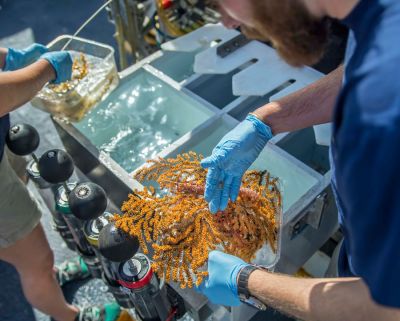Scientists from the Charles Darwin Foundation, the Galapagos National Park Directorate, the Ocean Exploration Trust, and individual biologists have joined hands to explore the deep sea to find out never seen before marine creatures.
By using Remote Operated Vehicles (ROVs), they explored areas over 3,400 meters below the ocean's surface and found 30 new species in the Galapagos Islands. These newly found species include corals, brittle stars, sponges, and crustaceans.
New Discovery

The team of scientists found 14 new species of corals, which include 10 species of bamboo corals and four species of octocorals. As per the Charles Darwin Foundation, one of them is "the first giant solitary soft coral known for the Tropical Eastern Pacific."
The scientists also found one new brittle star species, with longer whip-like arms that they use to crawl across the seafloor, 11 sponge species were also discovered from Galapagos Island. The exploration led the team to discover four new species of squat lobsters, which are closely related to hermit crabs. As per scientists these new lobster species have a flattened appearance and have sharp claws to defend against the predators.
These species were found deep down in the sea, specifically on the seamounts, underwater mountains, generally extinct volcanoes, which were left unexplored until recently. But thanks to technological evolution, researchers now are able to access these difficult underwater areas.
Dr. Leigh Marsh from the University of Southampton explained, "Seamounts are steep-sided underwater mountains formed from volcanic rock that generate complex currents compared to the surrounding flat seafloor. It is a combination of this topography along with a supply of food that falls from the surface ocean that creates favorable conditions for a diverse array of deep-sea communities to thrive."
In a statement, a marine scientist and study leader Pelayo Salinas de León said that the deep-ocean remains as "earth's last frontier," and the recent study provides a sneak-peak into "the least known communities of the Galapagos Islands."
During the research, the scientists collected biological and geological specimens using the ROV manipulator arm and suction samplers. Later, the specimens were sent to renowned deep-sea experts for identification. Dr. Nicole Raineault, Chief Scientist of the Ocean Exploration Trust said, "The many discoveries made on this expedition showcase the importance of deep-sea exploration to developing an understanding of our oceans and the power of telepresence to build a diverse team of experts."





Galapagos Discovery
The Galapagos where the scientists found all these amazing marine creatures is famous for its biodiversity. The island is situated 862 miles from the coast of mainland Ecuador, it plays an important role as the unique environment helps the species to adapt and evolve.
In 2017, a hybrid finch species was found on the island. In 2019, a species of giant tortoise, believed to have been extinct for more than 100 years, last time noticed in 1906, was found on the Galapagos island of Fernandina. Galapagos is a marine protected area and also known as a UNESCO World Heritage Site.








